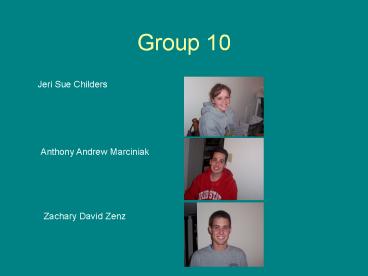ME 358 Semester Project - PowerPoint PPT Presentation
1 / 30
Title:
ME 358 Semester Project
Description:
The analytical method was completed in the MathCAD computer program. ... Microsoft Excel. Working Model 2D HW Edition 4.1. MathCAD 2001 Professional. CADKEY 99 ... – PowerPoint PPT presentation
Number of Views:50
Avg rating:3.0/5.0
Title: ME 358 Semester Project
1
Group 10
Jeri Sue Childers
Anthony Andrew Marciniak
Zachary David Zenz
2
Nogys Dream Machine
(Click picture to play movie)
Return to Position
Return to Velocity
Return to Acceleration
3
Table of contents
- Abstract
- Introduction
- Analysis
- Position
- Graphical
- Analytical
- Working Model
- Velocity
- Graphical
- Analytical
- Working Model
- Acceleration
- Graphical
- Analytical
- Working Model
- Results
- Position
- Velocity
- Acceleration
4
Abstract
- This project entailed designing a fourbar
mechanism that met detailed required guidelines.
The main concept was to use fourbar linkages to
create straight line motion, which had to be at
least 9 inches long. Also, the maximum velocity
output of the point moving on the straight line
had to be 10 in/s. With that in mind, the goal
was to create a mechanism that fit into the
smallest rectangular box possible, with at least
6 inches of clearance from the maximum
displacement of all bars. The bars had no length
restrictions, but they could only be 1 inch wide.
The motor that runs the mechanism must be
located between 3-5 ft (3650 inches) away from
the straight line motion. In addition, the only
design that was restricted was the Hoeken-type. - To begin this project, research was obtained
from the internet on various types of mechanisms
that created straight line motion. After
studying this information, two designs were
chosen to be considered. These designs included
a Watt type along with a Tchebicheff type. The
two types were analyzed and preliminary
calculations were made, and based on the project
restrictions the Tchebicheff style was chosen.
This combination of two fourbar mechanisms would
be the more simplistic of the two while occupying
the least amount of area. - The results obtained from the 3 different types
of analysis were very comparable. The analytical
method was the most accurate, but the graphical
didnt deviate much from the analytical values.
5
Introduction
- The primary use of this mechanism was to convert
a rotary input to straight line motion output. A
motor was attached to the input link to run the
fourbar device.
6
Analysis
- After the design of the mechanism was completed
on Working Model, the analysis begun. Since the
straight line distance was initially 50 inches,
based on the lengths of the bars, the first task
was to start scaling the entire design down.
This process was somewhat trial and error,
although for the most part the mechanism was
scaled down proportionally. The position of the
grounds also had to be slightly altered to
achieve only 9 inches of vertical motion. The
mechanisms position, velocity, and acceleration
was analyzed using three different methods
graphical, analytical, and Working Model. - For the graphical analysis, the design was drawn
in the CADKEY program, to reduce human error in
drawing it out by hand. This computer program
supplied pertinent information, such as the
values of angles. - The analytical method was completed in the
MathCAD computer program. The book formulas
were entered, along with known values from the
graphical analysis, to solve for the unknowns. - Finally, the Working Model program was used to
find the maximum velocity point, along with the
extremes of x and y. This is also where the
initial theta2 value that was used in the
position analysis came from.
7
Position
- Graphical
Maximum location of point P
8
Position
Point P at max. velocity
9
Position
Minimum location of point P
10
Position
- Analytical
11
Position
12
Position
13
Position
14
Position
15
Position
16
Position
- Working Model
17
Velocity
- Graphical
18
Velocity
- Analytical
19
Velocity
20
Velocity
- Working Model
21
Acceleration
- Graphical
22
Acceleration
- Analytical
23
Acceleration
24
Acceleration
- Working Model
25
Results
26
Results
27
Results
28
Results
- Based on the previous slides containing the Excel
charts, the methods of analysis were very
comparable. The analytical method was the most
accurate, but the graphical was very close to the
analytical values found. - This mechanism abides by all guidelines set forth
in the project requirements. It is a Tchebicheff
style mechanism that has approximately 10 inches
of straight line motion. The design is a
combination of two fourbar mechanisms, so it was
easy to break them apart and perform the
position, velocity, and acceleration analysis on
each.
29
Conclusion
- The purpose of this project was to build a
mechanism based on certain requirements that were
given. The design was researched, drawn, and
then the analysis was performed. This group used
three main forms of analysis learned in class
which included graphical, analytical, and Working
Model. The analytical method was the best method
to use because it produced the least amount of
error. - For the most part, this project went pretty well.
Decisions were made such as drawing the
mechanism in CADKEY to reduce error. However, in
order to improve this project, it would have
saved time to double check equations and units. - This mechanism fit into a 5.023 ft x 6.656 ft
rectangular box, allowing 6 inches from each
extreme point. So the total area of the box is
33.433 square feet.
30
Resources
- http//www.brockeng.com/mechanism/Tchebicheff.htm
- Norton, R.L., Design of Machinery, Third Edition,
McGraw-Hill, New York, 2004. - Microsoft Word
- Microsoft Excel
- Working Model 2D HW Edition 4.1
- MathCAD 2001 Professional
- CADKEY 99

